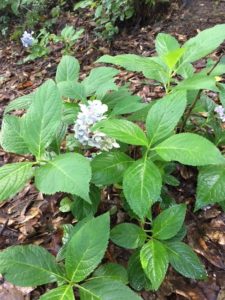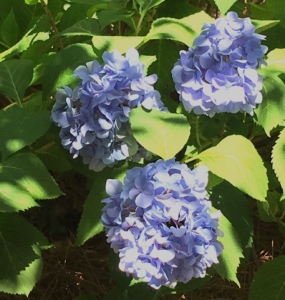I have a small confession to make. I have a hydrangea shrub that I planted about 10 years ago

– and it’s still less than two feet tall. It looks more like a ground cover than a shrub. This year it has a whopping 3 blossoms on it! No, it’s not a miniature, though it is small. It’s simply not getting what it needs to thrive. It’s a great example of survival vs. thrival (? is that a word?) In any case, it’s thrival rate is about zero. Of course I could move it, put it in a sunnier spot in better soil, but the optimist in me keeps thinking that this year will be the year for it to thrive. Not yet….
I love hydrangeas, even my little stunted, non-thriving one. They bridge the gap between May roses and the summer perennials and fill in the shady spots where early blooming azaleas began the garden season.

My favorites are two ‘Vince Doolie’s’ (named after University of Georgia’s famed football coach / gardener) that my son, Dave, gave me on Moth
er’s Day several years ago. These babies are thriving and heavily laden with big balls of intense blue. I also have a couple of lace-caps, which are more natural looking and fit into the back woodsy landscape seamlessly. This is also where I grow a few oak leaf hydrangeas, transplanted from my childhood home in Sandy Springs, Georgia. In the front, sunny garden, the white hydrangeas provide a cool backdrop for the phlox, beebalm and daylilies that are beginning to bloom.
Hydrangeas will thrive in well drained soils where they receive (preferably) morning sun and afternoon shade. They don’t like to be planted under trees where the roots compete for moisture. All of this explains why my 10 year old is so scrawny and why I should move it. This year.
It’s best to plant new hydrangeas in spring or fall, but if you are transplanting one, wait until it is dormant. They like a fair amount of moisture and are not shy in telling you when they are thirsty. They simply go limp when they are not getting enough to drink.
 It is true that you can change the color of a hydrangea blossom by changing the soil. It is also true that it’s not particularly easy to do it. Judith King, on her excellent website HydrangeasHydrangeas.com, says that the keyis aluminum. If you want a pink bloom, you need to take aluminum OUT of the soil. If you want a blue one, you want aluminum IN the soil. Plants take up aluminum best at a low PH so altering the acidity of the soil is also necessary. Judith suggests that if you’re determined to change a blossom color that perhaps the easiest way to do this is to grow it in a pot where you have more control over the composition and acidity of the soil. One more word about changing blossom colors – a white hydrangea will always be a white hydrangea.
It is true that you can change the color of a hydrangea blossom by changing the soil. It is also true that it’s not particularly easy to do it. Judith King, on her excellent website HydrangeasHydrangeas.com, says that the keyis aluminum. If you want a pink bloom, you need to take aluminum OUT of the soil. If you want a blue one, you want aluminum IN the soil. Plants take up aluminum best at a low PH so altering the acidity of the soil is also necessary. Judith suggests that if you’re determined to change a blossom color that perhaps the easiest way to do this is to grow it in a pot where you have more control over the composition and acidity of the soil. One more word about changing blossom colors – a white hydrangea will always be a white hydrangea.
Bringing hydrangea blossoms inside is easy – just cut, put in a vase full of water and enjoy, at least for a day or two before they begin to wilt. Although there are many different suggestions for drying hydrangea blossoms, the only one that works u nfailingly, is to wait until they begin to dry, then cut and arrange. Once they feel crisp to the touch, you can pick them and put them in a vase – and you don’t even need water! They will last a very long time before turning brown if you pick them just at the right time.
nfailingly, is to wait until they begin to dry, then cut and arrange. Once they feel crisp to the touch, you can pick them and put them in a vase – and you don’t even need water! They will last a very long time before turning brown if you pick them just at the right time.
Every winter, when hydrangea leaves drop and leave bare branches, I promise myself that I will plant more azaleas instead of more hydrangeas. But every June, when those balls of incomparably beautiful blue, pink and purple begin to bloom, I know that my love affair with hydrangeas will continue. Even for that scrawny little ten year old.

Our hydrangeas are tall and skinny and bloom very late. When is the best time to cut them back so that they are fuller?
Hi Pete, Thanks for your question.
It depends on what kinds of hydrangea you have. I assume it’s a mophead (the common pink or blue). If so, now is a great time to prune. Don’t prune any later than August when the shrubs begin to put out new growth and form buds. You can, and should, prune dead wood out of hydrangeas any time. Good luck!
These are white..they only just began to bloom. They were cut back, I think, in the fall and they are now 7′ or more and very leggy. They’re pretty..they just don’t look at all like the smaller bushy ones except that the blooms are pretty much the same. Thanks, Laura!!